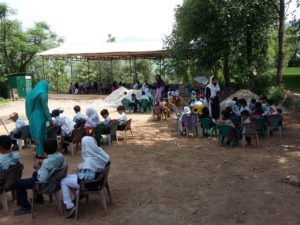The Children
Kashmir Notes Back to America: The Children
November 26, 2005
According to AJK official reports, in the quake epicenter at Muzaffarabad, Kashmir, at 8:50am on Saturday October 8th, 1,566 schools were totally destroyed and another 644 were partially destroyed. Virtually none went unscathed. This lopsided statistic illustrates the violence of the event: The number of schools that have been completely erased significantly outnumbers those that can be repaired.
For Kashmir school children, Fridays are half-days and Sundays are off. Juxtaposed between, Saturdays are full school days, and on this particular Saturday morning, the children were just getting settled into their studies.
Kashmir literally lost a generation as tens of thousands of children ages 6 to 18 perished. Their missing numbers are clearly obvious: In Muzaffarabad there simply aren’t many children milling about as is usual in third world countries. The ones who remain share a vacant, wild-eyed look. A common word used in this city is “affected” and it aptly describes these children. Many of them refuse to go to school, afraid the quake will return, associating the terrifying event with school itself. So many kids died, and the remaining few are emotionally crippled.
In Pakistan there are two kinds of schools providing their own distinct language curriculums. The majority of public grammar schools provide an Urdu-based syllabus in which the English language is not taught until the sixth grade. The typical private school, maybe 40% of the total, commences English lessons in the first grade. Today, in these tent camps and to the credit of the all-volunteer teachers, grammar school for these 5 to 12 year olds continues ad-hoc but a huge problem for the teachers is that former public school children are thrust into these essentially private schools and are lost in the English language-based curriculum. To compound the frustration, and notwithstanding the complete lack of books, paper and writing tools, the children and teachers have no chairs on which to sit. I came here with cash and I’ll see that a good share of it will be spent on chairs for these schools. It must be said that the majority of the volunteer teachers, as with nearly all of the children they teach, have suffered one or more deaths within their immediate families. The children are in a shell-shocked daze from it all and, for the adults in the camps, it has been so intense just keeping things going for themselves and for those around them that there has simply been no time to grieve for those who have been lost.
In Muzaffarabad the weather has been pleasant but I can’t imagine what it will be like for the children and teachers when the cold descends. In the winter it is nasty in these parts and keeping warm and focusing properly for hour after hour will likely be impossible. There are few tents large enough to house an entire class. More often, the physical school is a large tarp stretched above to at least keep the weather off the children. The sides are open, below is bare earth. It is late November and the Himalayan winter is a hair-breadth away.
The new citizens of Muzaffarabad are the back-country people. They have replaced the original residents, most of whom have long since departed for the cities down below: Islamabad, Peshawar and Lahore. I am at one of five tiny tent schools situated in the Jalal Abad Village Green Tent Camp. Beneath the stark canvas tarp overhead are the twenty children with their teacher. The typical physical accoutrements of school are not here: No chairs, books, paper or pencils. The children engage in group nursery rhymes and verbal counting calisthenics. They stand in perfect little lines, in rapt attention in their tidy uniforms, wholly absorbed by the teacher’s promptings. Eagerly rattling off the verbal drills in perfect accord with the teacher, these children are absolutely attentive without a hint of mischievousness. They have witnessed the unspeakable horror of the earthquake and its nightmarish aftermath. Looking in their eyes, one cannot mistake what has happened here.
I am back in Lahore now, collecting my thoughts and writing these reports. It was tough up there in Muzaffarabad, emotionally and physically, but I find myself wanting to return immediately if to do nothing more than hand out chocolates to the children and cash to their parents. It is really bad up there. These tent people, parents and children, are in states of profound anxiety and physical discomfort and, of course, one has to witness it in order to completely understand. Before my visit there, the faces and the stories were from another world and not my business. Now it’s personal and I can’t pretend that place is anything less than real.
I examine the life I lead back in the states. I have been here a week and will spend more time the quake zone before returning to my home in the USA in mid December. In my upscale Oregon resort community of 60,000, Christmas will happen with all the trappings. Then, I will be married on January 1st. I am expected to return to life in a beautiful home; a life interspersed with Yoga classes and latte’s; comfortable chatter in my clean and spacious office that is decorated precisely. In the evening, big screen TV will be watched from the leather couch. As I sit here at my laptop, haunted by the tent camp children’s eyes, I reflect now upon the general absurdity my too-soft western existence. Too much, my life has been wrapped up in things that do not matter.
So, as my life carries on from here, the minor details and the major efforts will be different. To the people who know me, I tell you to expect to see a change.
With Hassan, I will return to the epicenter on the day after tomorrow.
(series to be continued)
